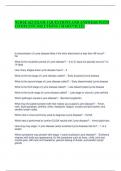NURSE 623 EXAM 1 QUESTIONS AND ANSWERS WITH
COMPLETE SOLUTIONS [ MARYVILLE]
Is transmission of Lyme disease likely if the thick attachment is less than 48 hours? -
No
What is the incubation period of Lyme disease? - 3 to 31 days but typically around 7 to
14 days
How many stages does Lyme disease have? - 4
What is the first stage of Lyme disease called? - Early localized Lyme disease
What is the second stage of Lyme disease called? - Early disseminated Lyme disease
What is the third stage of Lyme disease called? - Late disseminated Lyme disease
What is the fourth stage of Lyme disease called? - Late stage or chronic Lyme arthritis
Which pathogen causes Lyme disease? - Borrelia burgdorferi
What may the patient present with that makes you suspect Lyme disease? - Fever,
rash, facial paralysis, arthritis, chills, headache, fatigue, muscle and joint aches, and
swollen lymph nodes
Which test is most commonly used to diagnose Lyme disease? - ELISA
Which test is performed to confirm ELISA results with Lyme disease? - Immunoblot test
How long may stage 1 Lyme disease (early localized Lyme disease) last for? - 1 to 4
weeks
Which symptoms may present with stage 1 (early localized) Lyme disease? - Erythema
migrans with bulls eye appearance, flu like symptoms such as fever, chills, joint and
muscle pain, stiff neck and headache, general feeling of illness, and swollen lymph
glands
,A circular rash that may expand over time which may also have a bulls eye appearance.
- Erythema migrans
What is treatment for stage 1 (early localized) Lyme disease? - Doxycycline,
Cefuroxime, or amoxicillin
How soon may stage 2 (early disseminated) Lyme disease present after initial infection?
- Weeks to months
With this stage of Lyme disease, symptoms can range from mild to severe, or not at all.
Flu like symptoms may be similar to or worse than stage 1 and includes fever, chills,
joint and muscle pain, stiff neck and headache, swollen lymph nodes or glands, fatigue,
sore throat, visual disturbances such as blurry vision, paralysis or weakness in the face,
pain or numbness in the bite area, and heart palpitations. - Stage 2 (early
disseminated) Lyme disease
What is treatment of stage 2 (early disseminated) Lyme disease if IV treatment is
needed? - Azithromycin, doxycycline, amoxicillin, cefuroxime, or ceftriaxone. (Most
commonly is doxycycline except for children 8 years old and younger or
nursing/pregnant women).
What are oral antibiotic choices for treatment of stage 2 (early disseminated) Lyme
disease? - Azithromycin, doxycycline (except in children <8 years old, nursing or
pregnant women), amoxicillin, and cefuroxime. (Most common is doxycycline except for
<8 y.o., pregnant, or nursing).
When does stage 3 (late disseminated) Lyme disease typically present? - When the
infection has not been treated during stages 1 and 2. It starts months or even years
after the original tick bite.
What are symptoms of stage 3 (late disseminated) Lyme disease? - Severe
headaches, arthritis of the large joints (knees, hips, etc.), heart arrhythmia, brain
disturbances (memory loss, mood disturbances, sleep interruptions), difficulty
concentrating and mental fogginess, temporary amnesia, difficulty following
conversations or speaking, numbness or tingling in the limbs (arms, legs, feet, or
hands), extreme fatigue, and temporary paralysis of facial muscles
With this stage of Lyme disease, presentation is a recurrent form of joint inflammation
which may include episodes of severe arthritis symptoms. The most common joint
affected is the knee joint but it may also occur in other large or small joints as well. -
Stage 4- late stage or chronic Lyme arthritis
Which symptoms will present with stage 4 late stage or chronic Lyme arthritis? -
Swelling, redness, and fluid buildup with episodes lasting greater than 6 months
, How long may symptoms of stage 4 late stage or chronic Lyme arthritis last? - Months
to years
What history is important for assisting with the diagnosis of Lyme disease? - Exposure
to tick bites, recent camping trips, frequent yard work, pets that go outside and have
contact with the patient, duration and characteristics of lesion(s).
What is the dosage and duration and first line treatment for an adult with early Lyme
disease? - Doxycycline 100 mg PO BID for 14-21 days
What is the second line treatment for adults with early Lyme disease? - Amoxil 500 mg
TID for 14-21 days
What gis gthe gcausative gagent gof ginfectious gmono? g- g gEpstein gBarr gvirus
What gis gthe gincubation gperiod gfor ginfectious gmono? g- g g30 gto g50 gdays
How gis gmono gcontacted? g- g gPerson gvia gsaliva g(rarely gvia gblood)
What gis gthe gcommon gpresentation gof ginfectious gmono? g- g gFever, gpharyngitis,
gadenopathy, gfatigue, gHA, gglottis gedema, gpain gbehind geyes, gpetechiae grash gon gpalate
What glab gtest gwould gmost glikely gbe gelevated gwith ginfectious gmono?
A. ghgb
B. gMCHC
C. gliver gfunction gtest
D. gUA g- g gC
What gis gthe gduration gof ginfectious gmono? g- g g3 gto g4 gweeks
How glong gcan gfatigue glast gwith gmono? g- g g6 gto g12 gmonths
Which gpatient geducation gis gimportant gto gdiscuss gwith gmono?
A. gnone, git gis gall gin gtheir ghead
B. gdouching gevery gday
C. gsplenic grest g(no gcontact gsports gfor g3 gweeks)
D. gall gof gthe gabove g- g gC
Which gtests gshould gbe gordered gwith ginfectious gmono? g- g gCBC, gmonospot, gRPR gtiters,
gIgG, gIgM, grapid gstrep gtest
True gof gfalse: gMono gcan gcause gabnormal gLFT, gsplenic genlargement, glymphcytosis, gand
gfatigue. g- g gTrue
What gwould gIgG gshow gwith gmono? g- g gpast ginfection




